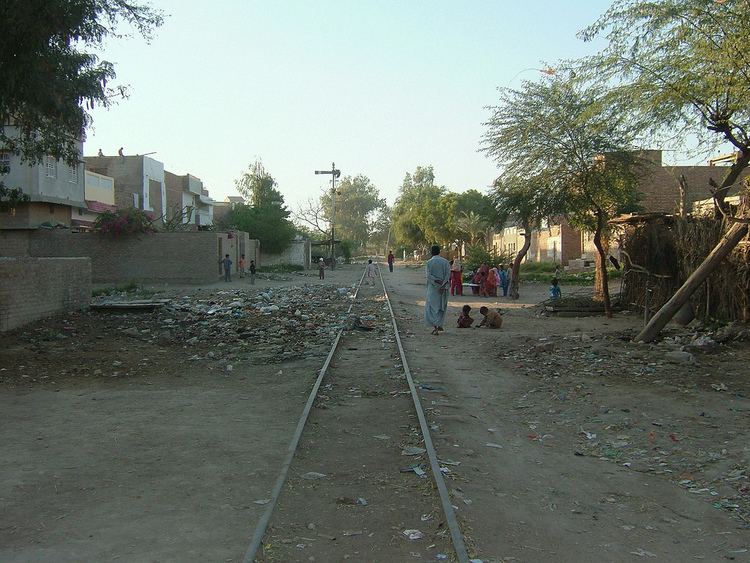Country District Shaheed Benazirabad | Population 189,244 (1998) Area 4,239 km2 | |
 | ||
University Quaid-e-Awam University of Engineering, Science and Technology | ||
Map of Nawabshah
Nawabshah (Sindhi and Urdu: نوابشاہ) is old name of Shaheed Benazir Abad District of Sindh province, Pakistan. It is the headquarters of the Shaheed Benazir Abad District and has a population of 1,135,131.
Contents
- Map of Nawabshah
- Eating peoples food prank
- Etymology
- Location
- Agriculture
- Climate
- By railroad
- By highways
- By air
- Archeology
- Events
- Notable people
- Schools colleges institutes NGOs and universities
- References
Eating peoples food prank
Etymology
Nawabshah derives its name from Syed Nawab Shah, from the Syed Family of the area, who in 1912 donated 200 acres of land for a railway station to the British Empire. In his honour, the British named it Nawabshah.
Location
It is roughly the geographical center of Sindh province of Pakistan. By road it is 4 hours' drive from the country's largest city and commercial capital Karachi on the National Highway N-5, roughly 50 kilometres from left bank of River Indus. The central geographical location of the city makes it a major train and road transportation hub in the province. It was established by the British Government in 1913.
Agriculture
The city of Nawabshah is set in a lush agricultural region. The city is famous for its sugarcane, mango, national hub of cotton production and one of the largest producer of banana in Pakistan. Nawabshah and its surrounding area produce a significant portion of the total banana production of Pakistan
Climate
The city is considered one of the hottest cities in Pakistan, with summer temperatures soaring as high as 53 °C. Temperatures above 45 °C are fairly common during late May and early June of the year. Winters start late, around mid-November, lasting to around mid-February, with night-time temperatures often reaching 4 °C, and temperatures below 0 occurring two or three times on average in January.
The highest temperatures each year in Pakistan, typically rising to above 50 °C (122 °F), are usually recorded in Nawabshah District and Sibi from May to August. The climate is generally dry and hot, but sometimes the temperature falls to 0 °C (32 °F). On January 7, 2011 temperatures dropped to −4 °C (25 °F) in the city.
By railroad
Nawabshah is a railway junction for:
- Main Railway line, Lahore to Karachi.
- Metre Gauge Line, Nawabshah to Jam Saheb & Mirpurkhas.
- Feeder Lines, Padidan, Mahrabpur via Tharushah to Sakrand Nawabshah and Sakrand to Tando Adam via Hala (entire line abandoned/disused).
By highways
- N-5 National Highway passing through Sakrand and Daulatpur Talukas.
- Nawabshah Sakrand Road.
- Nawabshah Kazi Ahmed Road.
- Nawabshah—Sanghar Road.
- Nawabshah Kumb (Mehran Highway) via Bandhi and Daur.
- Nawabshah 60th Mile and Military Chaks.
- Nawabshah Jam Sahib.
- Desert area road, Jam Sahib – Preetamabad District Sanghar.
- Moro Bandhi Road.
- Other link roads connecting Taluka / District Headquarters and others town.
- Nawabshah Khadar road via Mian Shora
By air
Nawabshah Airport is centered on the old (RAF) Royal Air Force World War II base, which is currently being used for commercial flights by Pakistan International Airlines (PIA), Air Blue, Shaheen Air and other local airline services. It is also an alternative to Karachi International Airport. Nowadays all commercial flights are suspended.
Archeology
The mausoleum of Thul Mir Rukun is an archaeological and historical tomb situated 15 kilometers away from the town of Daulatpur. A road from the town of Kazi Ahmed via Pabjo village leads to Thul Rukan, where one is able to reach this thousand-year-old archaeological construction. The height of this tomb is 60 feet from ground level. Henry Cousin, a British Archaeologist, wrote in his book "Sindhi's Archeology" (Sindhi Translation "Sindh Ja Qadeem Aasaar" by Ata Muhammad Bhambro) that the bricks used in the construction of this tomb were made and prepared in the Buddhist Rulers' period. The line painting for the birth of Gaotam Budh was clearly shown on the bricks, now preserved by the Sindh Archeological Department. He wrote that the ornaments, small effigies and statues were also found when the ground was dug around the tomb.
Chaheen Jo Daro is another archaeological site. It is near the village of Jamalkeerio 2 kilometers from Rohri Canal and 10 kilometers south side from Nawabshah.
Events
The H.M KHOJA Annual Flower Show was introduced by H.M Khoja in 1954 at Khoja Garden. The event is celebrated for 3 to 4 days. It was first organized under the chairmanship of Madam Faryal Talpur in the first tenure of district Nazim Nawabshah and was organized by Khalid Hussain Channa Distt: Naib Nazim e Ala'a, and D.C.O. Nawabshah Abdul Razaque Qureshi. It was also organised under the social, educational writer and worker Mr. Muhammad Saleh Billoo when he restarted the Annual Flower Show from February 1988.
Notable people
Schools, colleges, institutes, NGOs and universities
There are various educational institutions in the city, these include:
